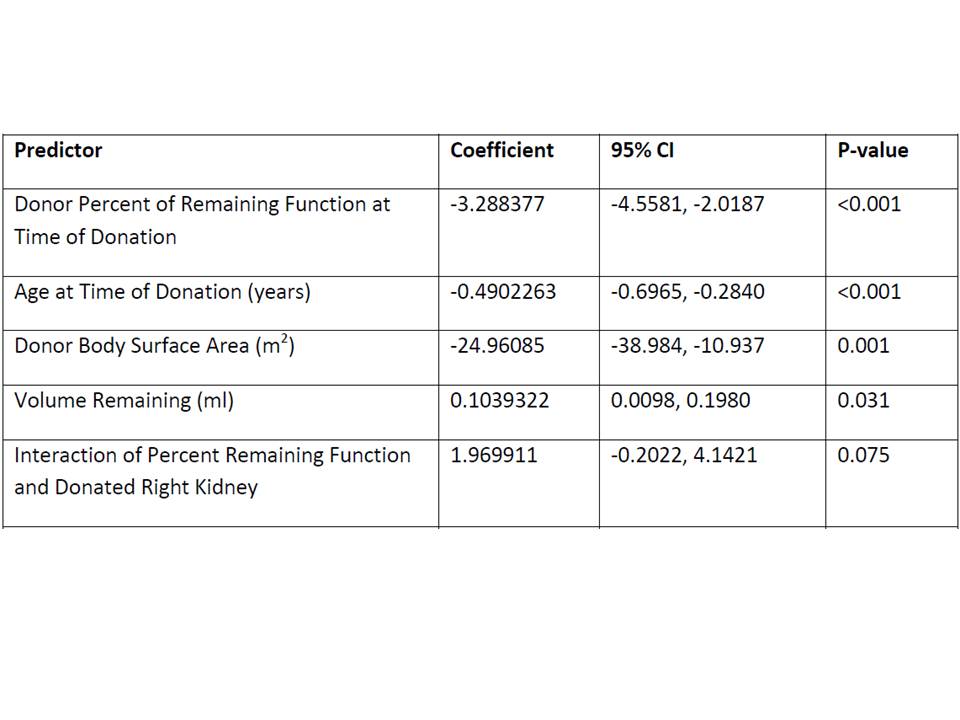Predicting Residual Renal Compensation in Living Kidney Donors Post-Donation.
Ohio State University College of Medicine, Columbus, OH
Meeting: 2017 American Transplant Congress
Abstract number: A239
Keywords: Donation, Kidney transplantation, Renal function
Session Information
Session Name: Poster Session A: Living Donor Kidney Transplant I
Session Type: Poster Session
Date: Saturday, April 29, 2017
Session Time: 5:30pm-7:30pm
 Presentation Time: 5:30pm-7:30pm
Presentation Time: 5:30pm-7:30pm
Location: Hall D1
In living kidney donors it is well established that post-donation the remaining kidney undergoes functional hypertrophy; resulting in a 20% – 40% in increase in GFR. Individual variability in the compensating renal hypertrophy ultimately affect the terminal GFR. Individual variables associated with renal hypertrophy remaining unclear.
We set forth to determine the mean quantity and factors predictive of functional hypertrophy in the remaining kidney post donation. Under IRB approval, we designed a single center retrospective study of all consecutive living kidney donors who donated in a 5 year time period, abstracting demographic and clinical data, pre and post donation eGFR at 1 year (calculated using CKD-EPI) and pre-donation renal volumes (obtained by 3D reconstruction of CT angiograms).
244 cases met inclusion criteria; (Male vs Female 85:159 (35%:65%); White vs Non-White = 205:39 (84%:16%); Ave Age: 44y/o (sd 11.58); Ave Body Surface Area (BSA): 1.94 (sd 0.24). The average total CT-V (combined right and left kidneys) was 352.73 ml (sd 72.25). The average pre donation GFR (CKD-EPI) was 102.31 ml/min (sd 18.6). The expected post-donation GFR (Pre-donation GFR corrected for % remaining renal volume) was 51.04 ml/min (sd: 9.7). At 1 year post donation the observed GFR was 67.65 ml/min (sd:17.61). The mean functional hypertrophy was 32.42% (sd:20.8).
Univariable regression modeling (unadjusted) showed that donation of left kidney; higher pre-donation GFR; higher remaining renal volume, % remaining renal function, lower female sex; younger age; lower donor height, weight, BSA and BMI; are all significantly associated with an increased hypertrophy at the α=0.05 level. Multivariable regression modeling (adjusted) confirmed, Donor Age, BSA, Graft Laterality, pre-donation remaining renal volume and renal function as all being significantly associated with renal hypertrophy post donation(p< 0.01). This study concludes that in living kidney donors it may be possible to predict renal function at 1 year post-donation. This in turn will aid in medical decision-making for risk stratification and informed consent of potential donors.
This study concludes that in living kidney donors it may be possible to predict renal function at 1 year post-donation. This in turn will aid in medical decision-making for risk stratification and informed consent of potential donors.
CITATION INFORMATION: Diez A, Diltz G, Von Visger J, Nori U, Pesavento T, Pelletier R. Predicting Residual Renal Compensation in Living Kidney Donors Post-Donation. Am J Transplant. 2017;17 (suppl 3).
To cite this abstract in AMA style:
Diez A, Diltz G, Visger JVon, Nori U, Pesavento T, Pelletier R. Predicting Residual Renal Compensation in Living Kidney Donors Post-Donation. [abstract]. Am J Transplant. 2017; 17 (suppl 3). https://atcmeetingabstracts.com/abstract/predicting-residual-renal-compensation-in-living-kidney-donors-post-donation/. Accessed December 16, 2025.« Back to 2017 American Transplant Congress
